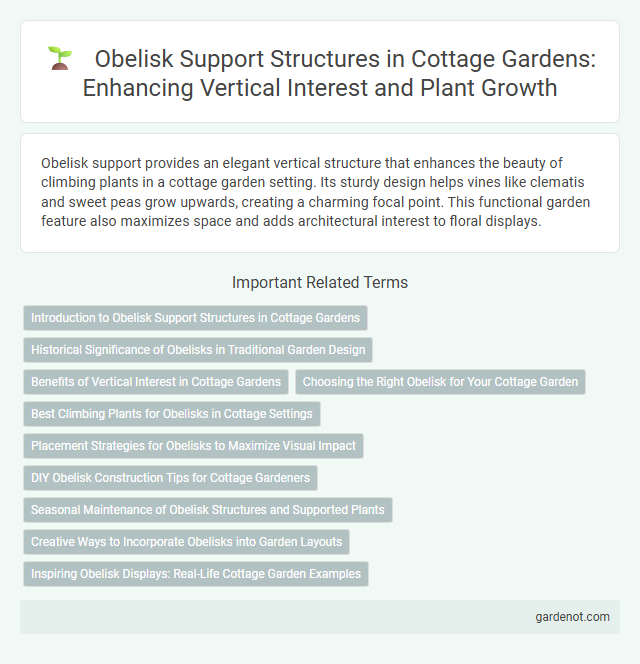Obelisk support provides an elegant vertical structure that enhances the beauty of climbing plants in a cottage garden setting. Its sturdy design helps vines like clematis and sweet peas grow upwards, creating a charming focal point. This functional garden feature also maximizes space and adds architectural interest to floral displays.
Introduction to Obelisk Support Structures in Cottage Gardens
Obelisk support structures in cottage gardens are vertical frameworks designed to provide climbing plants with stability and shape. These garden features typically consist of tall, slender wooden or metal frames that enhance vertical interest while supporting vines like clematis, roses, and sweet peas. Incorporating obelisks helps maximize garden space and creates a charming focal point that complements the informal, lush aesthetic of cottage gardens.
Historical Significance of Obelisks in Traditional Garden Design
Obelisk supports have a rich historical significance in traditional garden design, serving as vertical focal points that enhance the visual structure of cottage gardens. Originating from ancient Egyptian architecture, obelisks were adapted in European garden layouts during the Renaissance to symbolize strength and elegance. Their incorporation in cottage gardens provides climbing plants with sturdy support while maintaining a timeless aesthetic that connects modern gardening with historical artistry.
Benefits of Vertical Interest in Cottage Gardens
Obelisk supports in cottage gardens create vertical interest by allowing climbing plants like roses, clematis, and sweet peas to grow upward, maximizing limited garden space. This vertical growth not only enhances visual appeal but also improves air circulation around plants, reducing disease risks. Elevating blooms on obelisk supports draws the eye upward, adding depth and structure to the informal, lush aesthetic characteristic of cottage gardens.
Choosing the Right Obelisk for Your Cottage Garden
Selecting the right obelisk for your cottage garden involves considering materials like rust-resistant metal or weather-treated wood to ensure durability and aesthetic harmony with natural surroundings. Choose an obelisk height that supports the growth habits of climbing plants such as clematis, sweet peas, or climbing roses, providing ample vertical structure without overwhelming delicate blooms. Opt for designs featuring open frameworks to promote air circulation, reduce disease risk, and integrate seamlessly into the informal, lush style characteristic of cottage gardens.
Best Climbing Plants for Obelisks in Cottage Settings
Obelisks provide vertical structure in cottage gardens, ideal for supporting climbing plants like Clematis, Honeysuckle, and Sweet Pea, which thrive in such environments. Clematis varieties with large, colorful blooms add vibrant seasonal interest, while Honeysuckle offers fragrant flowers that attract pollinators, enhancing biodiversity. Sweet Pea's delicate, ornamental flowers complement the traditional cottage garden aesthetic, making these climbers perfect companions for obelisk supports.
Placement Strategies for Obelisks to Maximize Visual Impact
Strategic placement of obelisk supports within cottage gardens enhances vertical interest and draws the eye to key floral displays or pathways. Positioning obelisks near climbing plants, such as clematis or roses, creates dynamic focal points that blend structure with natural growth. Placing obelisks at garden corners or entryways maximizes their visual impact by framing views and adding architectural elegance.
DIY Obelisk Construction Tips for Cottage Gardeners
DIY obelisk construction in cottage gardens enhances vertical interest and supports climbing plants like clematis and sweet peas. Use weather-resistant materials such as cedar or treated wood, ensuring sturdy joints with screws rather than nails for long-lasting durability. Painting or staining the obelisk protects it from moisture, while anchoring it securely into the ground maintains stability against wind and plant growth.
Seasonal Maintenance of Obelisk Structures and Supported Plants
Seasonal maintenance of obelisk supports involves regularly inspecting the frame for stability and repairing any damage caused by weather exposure. Supported plants, such as climbing roses or clematis, require pruning during their dormant season to encourage healthy growth and prevent overgrowth on the obelisk. Applying a balanced fertilizer in early spring enhances root development and bloom production, ensuring the structure remains both functional and visually appealing throughout the growing season.
Creative Ways to Incorporate Obelisks into Garden Layouts
Obelisk supports add vertical interest and structure to cottage gardens, perfect for climbing roses, clematis, or sweet peas. Positioning obelisks near beds or pathways creates focal points while enhancing plant growth by providing essential support. Combining multiple obelisks in varying heights and materials like wood or metal can define garden zones and boost overall aesthetic appeal.
Inspiring Obelisk Displays: Real-Life Cottage Garden Examples
Inspiring obelisk displays in cottage gardens create vertical focal points that enhance the natural charm and dense planting typical of this garden style. Real-life examples showcase obelisks draped with climbing roses, clematis, and sweet peas, providing structure and height amidst the informal, overflowing beds. These garden features not only support vigorous vines but also add a timeless architectural element that complements the soft, romantic aesthetics of a cottage garden.
Obelisk support Infographic

 gardenot.com
gardenot.com